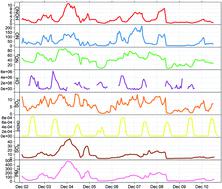当前位置:
X-MOL 学术
›
Faraday Discuss.
›
论文详情
Our official English website, www.x-mol.net, welcomes your
feedback! (Note: you will need to create a separate account there.)
Insights into air pollution chemistry and sulphate formation from nitrous acid (HONO) measurements during haze events in Beijing
Faraday Discussions ( IF 3.3 ) Pub Date : 2020-9-21 , DOI: 10.1039/d0fd00100g William J Bloss 1 , Louisa Kramer , Leigh R Crilley , Tuan Vu , Roy M Harrison , Zongbo Shi , James D Lee , Freya A Squires , Lisa K Whalley , Eloise Slater , Robert Woodward-Massey , Chunxiang Ye , Dwayne E Heard , Shengrui Tong , Siqi Hou , Yele Sun , Jingsha Xu , Lianfang Wei , Pingqing Fu
Faraday Discussions ( IF 3.3 ) Pub Date : 2020-9-21 , DOI: 10.1039/d0fd00100g William J Bloss 1 , Louisa Kramer , Leigh R Crilley , Tuan Vu , Roy M Harrison , Zongbo Shi , James D Lee , Freya A Squires , Lisa K Whalley , Eloise Slater , Robert Woodward-Massey , Chunxiang Ye , Dwayne E Heard , Shengrui Tong , Siqi Hou , Yele Sun , Jingsha Xu , Lianfang Wei , Pingqing Fu
Affiliation

|
Wintertime urban air pollution in many global megacities is characterised by episodic rapid increase in particulate matter concentrations associated with elevated relative humidity – so-called haze episodes, which have become characteristic of cities such as Beijing. Atmospheric chemistry within haze combines gas- and condensed-phase chemical processes, leading to the growth in secondary species such as sulphate aerosols. Here, we integrate observations of reactive gas phase species (HONO, OH, NOx) and time-resolved aerosol composition, to explore observational constraints on the mechanisms responsible for sulphate growth during the onset of haze events. We show that HONO abundance is dominated by established fast gas-phase photochemistry, but the consideration of the additional formation potentially associated with condensed-phase oxidation of S species by aqueous NO2 leading to NO2− production and hence HONO release, improves agreement between observed and calculated gas-phase HONO levels. This conclusion is highly dependent upon aerosol pH, ionic strength and particularly the parameterisation employed for S(IV) oxidation kinetics, for which an upper limit is derived.
更新日期:2020-09-21









































 京公网安备 11010802027423号
京公网安备 11010802027423号